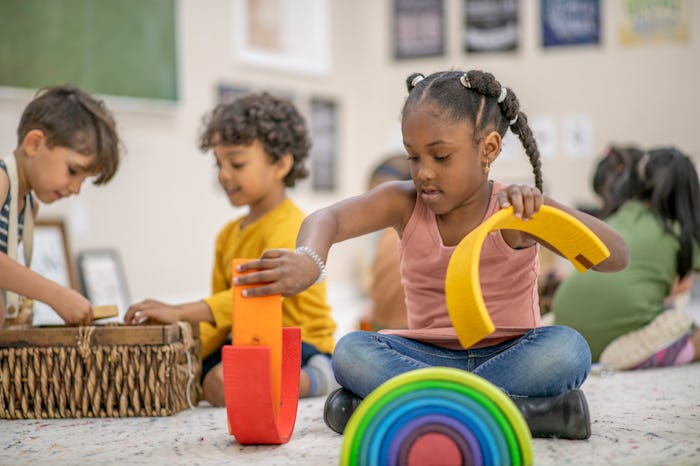Education

Everything Parents Need To Know About The Reggio Emilia Approach
It’s all about collaboration and exploration.
Parents who have researched alternative schools and/or non-traditional curriculums may have come across the concept of the Reggio Emilia approach or schools inspired by the philosophy, as it continues to become more and more popular across the US. But, what is the Reggio Emilia Approach, exactly and who is it good for? What makes this model different from others?
What Is The Reggio Emilia Approach?
Reggio Emilia is not a person, it is a city in Italy where this educational philosophy and pedagogy originated after World War II and is most commonly used in preschool and early elementary classrooms. Unlike in traditional-model schools where lessons are teacher-led, educators that follow the Reggio Emilia approach let the students lead the way and offer guidance, knowledge, and direction as needed. “Teachers are closely observing children to help them in planning and offering learning opportunities that will connect to their interests or questions,” Reggio Emilia teacher Julie Alberson, M.Ed., tells Romper in an email. “This shows the children that their ideas, thoughts, passions, experiences, and preferences are valued.”
Even though they aren’t leading a class in the traditional sense, teachers are still observing the students’ academic growth and evolving their classrooms as needed to ensure students have the tools they require to master benchmark skills. “Teachers are consistently documenting the learning and making it visible to children, parents, and the community,” explains Alberson. “Documentation provides the opportunity for children to reflect and revisit learning experiences [and] reflecting with the children allows them to make meaning of the work and helps plan for future learning experiences.”
Reggio Emilia-inspired curriculum is emergent, hands-on, collaborative, and taught through projects, exploration, and play. Because of this, the classroom’s setup is very important. “The environment is set up as the ‘3rd teacher’ so children can independently engage and learn in a space that has been intentionally set up to be beautiful, engaging, encourage investigation, and promote relationship building,” describes Alberson. Additionally, materials are carefully chosen based on sensory elements and kept within reach of the students, and learning spaces are set up so that there is enough room for multiple kids to work together.
What Are The Benefits Of the Reggio Emilia Approach?
The Reggio Emilia approach falls somewhere between Montessori and traditional classrooms, in that there are still daily routines (like the traditional model) but the actual learning is student-led (like Montessori), so it’s the best of both worlds. However, unlike traditional and Montessori schools, this approach gives kids the freedom of demonstrating their knowledge through various methods, which Alberson says are referred to as “languages.” “Children are telling us what they know as they build, dance, draw, paint, sculpt, create, explore, read, write, observe, investigate, experiment, garden, dream, engineer, talk, act, cook, etc.” she explains, “The ‘languages’ demonstrate that there are many ways for children to express themselves outside of writing and speaking.”
Other benefits of the Reggio Emilia approach include:
- A relaxed learning environment that encourages exploration
- Teacher-student relationships that are rooted in respect
- Students build social skills through a collaborative environment
- A student-led approach allows consistent opportunities for problem-solving
- Kids develop a strong sense of community
- Emphasis on creativity and artistic expression
- Adaptive curriculum means lesson plans are created based on what the students need to master a skill (as opposed to standard curriculum that continuously moves forward and can leave some students behind)
All of that being said, the benefit Alberson says is the most important is that “children are shown that learning is a joyful experience.”
How Much Do Reggio Emilia Schools Cost?
Sending your preschooler or elementary-aged child to a Reggio Emilia school full-time can cost anywhere from $250 a week or more, depending on the school and the average cost of living where it is located. Some schools do offer scholarships or sliding scales based on income, and some states offer school vouchers to help offset the cost of sending a child to a private school instead of a public. You may also find that some teachers have Reggio Emilia-inspired classrooms even though they’re within a more traditional school or center (which might have a lower price tag), however, that does not guarantee that as your child grows and moves to a new class their next teacher will have the same teaching philosophy.
There are benefits to every type of school model, but every kid is different and a curriculum that works great for one child may not be ideal for another. The Reggio Emilia approach is worth looking into, especially for parents with kids who love to explore and thrive in hands-on environments.
Experts:
Julie Alberson, M.Ed., Reggio Emilia-Inspired Educator with a Masters Certification in Pedagogical Coordination in the Reggio Emilia Approach for Early Childhood Education
This article was originally published on